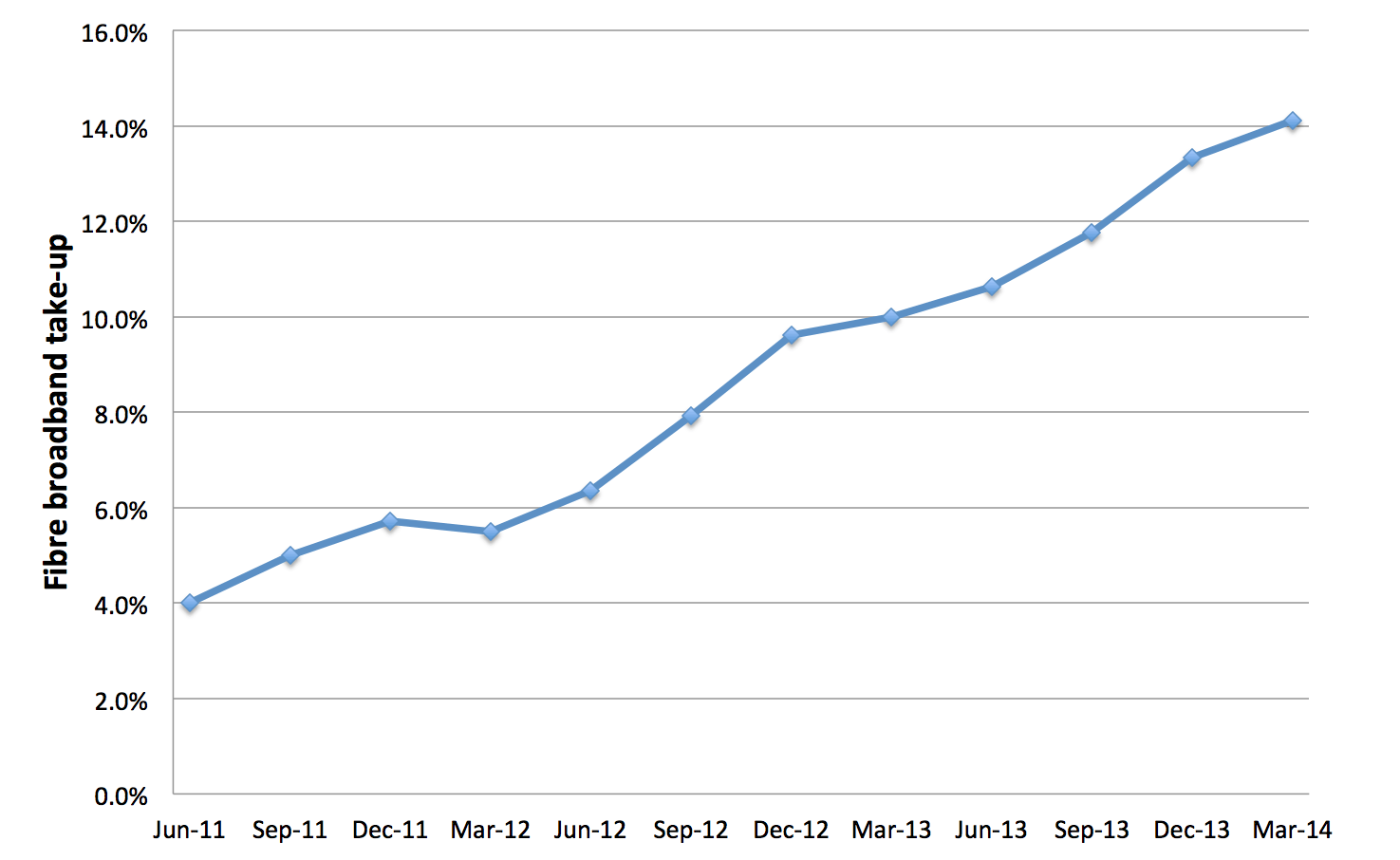 As an enthusiast for superfast broadband, widespread availability of superfast broadband services across the UK cannot come too soon! With BT’s commercial fibre broadband roll-out coming to end with the provision of fibre broadband to around two thirds of premises in the UK, government and local authority investment has been essential to roll out superfast broadband to the vast majority of premises.
As an enthusiast for superfast broadband, widespread availability of superfast broadband services across the UK cannot come too soon! With BT’s commercial fibre broadband roll-out coming to end with the provision of fibre broadband to around two thirds of premises in the UK, government and local authority investment has been essential to roll out superfast broadband to the vast majority of premises.
Local BDUK-related schemes across the country are now gathering pace. Recently, BT announced its results for the fourth quarter to the end of March 2014. BT reported that its fibre network passed more than 19 million premises by the end of March 2014, which represents around two thirds of the UK. BT currently looks to be on track to achieve about 90% of UK premises having access to fibre broadband by the end of 2015.
For the country to achieve the economic and social benefits of high-speed broadband access, widespread availability is not sufficient. Businesses and consumers will actually have to take up such services.
In areas covered by fibre broadband, take-up has so far been relatively modest, and there is no sign yet of a substantial upward trend in adoption (as shown in the figure below). In early February 2014, we reported that take-up of fibre broadband reached 13.3% of premises passed by the end of December 2013. BT’s latest data reveals that fibre broadband take-up reached about 14.1% at the end of March 2014, representing a very modest 0.8 percentage point increase in the quarter. Across the total number of UK premises, take-up of fibre broadband remained below 10%.

Figure: Take-up of fibre broadband as a proportion of premises passed
These numbers are quite disappointing and point to a failure of effective demand stimulation from ISPs, particularly as relatively affordable fibre broadband services are now available from a number of suppliers. For BDUK-related projects, the current low take-up is of concern. Given the huge investment that is being made by Government and local authorities, it is hard to justify such investments if take-up remains low, and the targeted economic and social benefits used to justify these investments will not be achieved without substantial take-up.
In June 2012, Point Topic published its report entitled Strategies for Superfast Demand Stimulation and suggested that “focus is shifting to stimulating demand for the superfast services” that fibre broadband infrastructure will enable. Nearly two years on from this report, we see relatively little widespread evidence that local authorities are seizing the opportunity to go beyond viewing their remit as basically managing infrastructure roll-out.
Although many local authority projects have run demand registration schemes, these have been focused on demonstrating to BT high demand for superfast broadband, to help secure the best deal in contract negotiations. Point Topic reported that “strong” and “active” support by local people “counts for much”, with local campaigning and support being ultimately what counts in demand registration. According to Point Topic, local champion schemes “that get individuals involved to act as ambassadors for superfast broadband have real traction”, claiming that areas in which local champion schemes are active see better registration numbers than areas without.
Certainly within my own county of Cambridgeshire, the Connecting Cambridgeshire project claimed that it was able to secure a better deal with BT compared with other counties (to roll out fibre broadband to 97% of premises by the end of 2015) as a result of achieving a high number of registrations (23,000) across Cambridgeshire as part of its demand registration scheme. 25 parishes in the county achieved registration totals above 50% of premises, with eight parishes achieving registration totals greater than 75% of premises due to the presence of active Broadband Champions.
Beyond the use of local Broadband Champions to help secure better terms with BT, there has been less evidence that local authorities across the UK have been focused on leveraging the support of local people to drive the take-up of fibre broadband services. Yet, the presence of proactive Champions can have a huge impact.
For example, the small village of Grafham in Cambridgeshire was one of the very first villages to benefit from the Connecting Cambridgeshire project, and fibre broadband services went live in November 2013. Connecting Cambridgeshire initially led a demand registration registration scheme prior to securing its contract with BT. With strong campaigning from its two Broadband Champions Grafham achieved 258 registrations, representing 97% of premises. Before and after switch-on, the Broadband Champions led a number of superfast broadband awareness and information campaigns, maintaining high visibility within the village. Within two months of fibre broadband becoming available, almost a third of the village was connected. Within six months following the launch of fibre broadband, fibre penetration in Grafham had reached 56.4%.
The first fibre broadband connections in the village of Spaldwick, as part of the Connecting Cambridgeshire project, took place at the beginning of July 2014. Within just one month, fibre broadband penetration had reached 40% of households – nearly three times of the national penetration of fibre broadband.
The key opportunity for BDUK-related projects across the UK is now to seize the enthusiasm, knowledge and commitment of local Broadband Champions, many of whom have a position of trust in their local communities. The replication of local successes on a national basis would have a dramatic impact on fibre broadband take-up.
